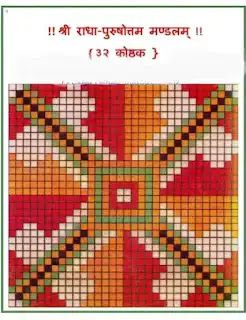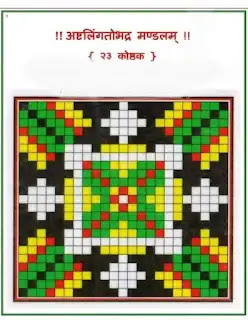Vaidic Vedi Chakra (Vaidic Mandal Nirman)
।। श्रीराधाकृष्ण चरणकमलेभ्यो नम: ।।
Vaidic Mandal Nirman is a term that refers to the construction of a Vedic altar or platform for performing rituals and ceremonies. The Vedic altar is a geometric representation of the cosmos and the divine order, and it is built according to precise measurements and proportions. The Vedic altar is also a symbol of the fire that consumes it, as well as the link between the human and the divine realms.
There are different types of Vedic altars, depending on the purpose and the deity to whom they are dedicated. Some of the common types are:
- Surya Mandal: This is a circular altar dedicated to Surya, the sun god. It has 12 spokes representing the 12 months, and 360 pegs representing the 360 days of the year. The diameter of the circle is equal to the height of the Centre.
- Ram Bhadra Mandal: This is a square altar dedicated to Rama, the incarnation of Vishnu. It has four corners representing the four directions, and four gates representing the four Vedas. The length of each side is equal to the height of the Centre.
- 64 Yogini Mandal: This is a hexagonal altar dedicated to the 64 yoginis, or female deities associated with Shakti, the goddess of power. It has six sides representing the six seasons, and six triangles representing the six tastes. The length of each side is equal to one-fourth of the height of the Centre.
- Navdurga Dwadash Aditya Mandal: This is a combination of two altars, one circular and one square, dedicated to Navdurga, the nine forms of Durga, and Dwadash Aditya, the 12 forms of Surya. The circular altar is inside the square altar, and both have 12 divisions representing the 12 zodiac signs. The diameter of the circle and the length of each side of the square are equal to one-third of the height of the Centre .
The construction of a Vedic altar requires a lot of skill and knowledge, as well as various materials such as bricks, clay, sand, grass, wood, etc. The process involves several steps such as selecting a suitable site, measuring and marking the dimensions, laying out the foundation, arranging the bricks in specific patterns, filling up the gaps with clay or sand, decorating and consecrating the altar, etc. The construction of a Vedic altar is also accompanied by various mantras and rituals that invoke and worship the deities.

























Comments
Post a Comment
।।श्रीराधाकृष्ण विजयतेतराम।।